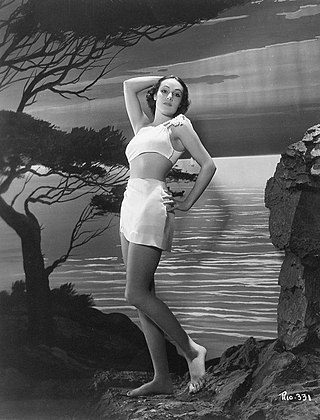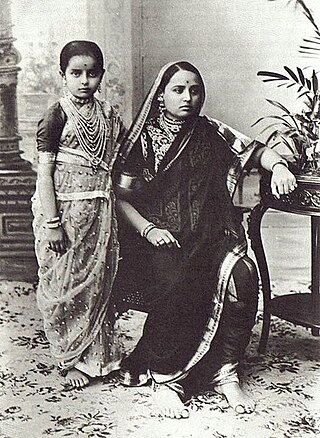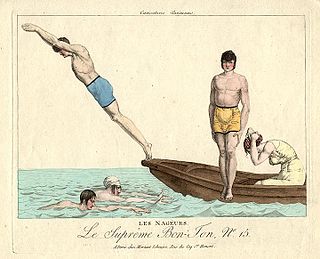

In fashion, the midriff is the human abdomen. The midriff is exposed when wearing a crop top or some forms of swimwear or underwear.


In fashion, the midriff is the human abdomen. The midriff is exposed when wearing a crop top or some forms of swimwear or underwear.
"Midriff" is a very old term in the English language, coming into use before 1000 AD. [1]
In Old English it was written as "midhrif", with the old word "hrif" literally meaning stomach; [2] in Middle English, it was "mydryf". [1] The word fell into obsolescence after the 18th century.
The word was revived in 1941 by the fashion industry, [2] partly to avoid use of the word "belly" which genteel women considered undesirable in reference to their bodies, as it has connotations of obesity.

In some cultures, exposure of the midriff is socially discouraged or even banned, and Western culture has historically been hesitant in the use of midriff-baring styles. Bill Blass commented:
It is too difficult. Women will much more readily wear bare-back or plunging-neckline styles. [3]
It was introduced to fashion in 1932 by Madeleine Vionnet when she offered an evening gown with strategically cut openings at the waist.
Women's swimwear of the 1930s and 1940s incorporated increasing degrees of midriff exposure.
Teen magazines of the late 1940s and 1950s featured similar designs of midriff-baring suits and tops. However, midriff fashion was stated as only for beaches and informal events and considered indecent to be worn in other public situations. [4]
However, exposure of the female midriff and navel was widely brought into everyday Western women's fashion in the 1960s' sexual revolution and later with the popularity of halters, tube tops and crop tops in the 1970s.
The cheerleading style fashions developing largely from the styles originating with the Dallas Cowboys Cheerleaders in the early 1970s also played a crucial role in the popularity of midriff fashion at middle and high schools. [4] [5]

During the 1980s, pop star Madonna appeared in bare midriff looks in her performances and music videos, which helped in spreading this fashion widely. [4] [6]
The popularity of the bare midriff continued well due to low-rise fashion which started in the early 1990s when the British magazine The Face in its March 1993 issue cover featured Kate Moss in low-rise jeans. [7] At the same time, the wide acceptance of navel display in Western societies, navel piercing [8] and navel tattoos [9] have become more common among young women. This raised the popularity of crop tops that expose the midriff and navel. [10]
During the 1990s, many designers adapted to the trend. One way of showing the midriff that has proved popular with designers is simply fastening a jacket or vest at the neckline and letting it fall freely. When the wearer moves, there is a flash of skin, but nothing startling. Fashion designer Carolina Herrera said, "the midriff doesn't have to be completely bare; a veil of chiffon over the midriff can look intriguing." [11]
The bare midriff, with flat, toned abs, became the trend in Hollywood in the 2000s. [12] Particularly present were the bare midriffs of Britney Spears, Jennifer Lopez and Christina Aguilera. [13] [14] [15] [16] [17]
Beginning in the late 1940s, school dress codes in the United States started to ban bare midriffs. [4]

Indian women have traditionally worn saris that partially cover the midriff, especially South Indian women. [18] [19]
The sari adapts to a woman's body, rather than defining it, allowing for pregnancy and otherwise expanding girth. In a culture where having enough to eat is not a given, rolls of fat around the midriff are a sign of prestige, rather than indulgence. [20] Torsekar, a paediatrician from India who works in Toledo, Ohio, once said, "It may be hard for American women to imagine going to work with an exposed midriff, but for Indian women, the midriff is considered no more suggestive than the forearm." [21]
Other Indian communities that take midriff in their stride include the women from Rajasthan, who leave the midriff exposed while wearing ghagra cholis. [22] However, these women often cover their heads with a dupatta [23] and even cover their faces in front of strangers, which enforces the belief that midriff-baring in India has a symbolic, almost mystical, association with birth and life and that the display is meant to emphasise the centrality of nature in the nurture role. [24]
In spite of it, some Indian philosophers gave opposition to exposing midriff in saris. They considered it to be a symbol of adultery. [25]

A bikini is a two-piece swimsuit primarily worn by girls and women that features one piece on top that covers the breasts, and a second piece on the bottom: the front covering the pelvis but usually exposing the navel, and the back generally covering the intergluteal cleft and a little, some, or all of the buttocks. The size of the top and bottom can vary, from bikinis that offer full coverage of the breasts, pelvis, and buttocks, to more revealing designs with a thong or G-string bottom that covers only the mons pubis, but exposes the buttocks, and a top that covers only the areolae. Bikini bottoms covering about half the buttocks may be described as "Brazilian-cut".

A navel piercing is a type of piercing that penetrates the skin of the navel. It is most commonly located on the upper fold of skin but can also be affected underneath or around the edges of the navel. Healing usually takes around 6–12 months but varies person-to-person due to differences in physiology.

The navel is a protruding, flat, or hollowed area on the abdomen at the attachment site of the umbilical cord. All placental mammals have a navel, although it is generally more conspicuous in humans.

A sari is a women's garment from the Indian subcontinent, that consists of an un-stitched stretch of woven fabric arranged over the body as a robe, with one end attached to the waist, while the other end rests over one shoulder as a stole (shawl), sometimes baring a part of the midriff. It may vary from 4.1 to 8.2 metres in length, and 60 to 120 centimetres in breadth, and is form of ethnic wear in India, Sri Lanka, Nepal, Bangladesh and Pakistan. There are various names and styles of sari manufacture and draping, the most common being the Nivi style. The sari is worn with a fitted bodice also called a choli and a petticoat called ghagra, parkar, or ul-pavadai. It remains fashionable in the Indian subcontinent today.
Clothing in India varies with the different ethnicities, geography, climate, and cultural traditions of the people of each region of India. Historically, clothing has evolved from simple garments like kaupina, langota, achkan, lungi, sari, to rituals and dance performances. In urban areas, western clothing is common and uniformly worn by people of all social levels. India also has a great diversity in terms of weaves, fibers, colors, and the material of clothing. Sometimes, color codes are followed in clothing based on the religion and ritual concerned. The clothing in India also encompasses a wide variety of Indian embroidery, prints, handwork, embellishments, and styles of wearing clothes. A wide mix of Indian traditional clothing and western styles can be seen in India.

The tankini is a bathing suit combining a tank top, mostly made of spandex-and-cotton or Lycra-and-nylon, and a bikini bottom introduced in the late 1990s. This type of swimwear is considered by some to provide the coverage of a one-piece suit with the convenience of a two-piece suit, as the entire suit need not be removed in order to use a toilet. Tankinis come in a variety of styles, colors, and shapes, and some include features such as integrated push-up bras. It is particularly popular as children's beachwear, and is considered an athletic outfit fit for a triathlon. According to Katherine Betts, Vogue's fashion-news director, this amphibious sportswear for sand or sea lets users go rafting, play volleyball, and swim without worrying about losing their tops.

A crop top is a top that reveals and exposes the waist, navel, or abdomen.

Low-rise pants, also known as "low-cut jeans", "lowriders" or "rap pants", are a type of pants that sit low on, or below, the hips, usually at least 8 centimetres (3 inches) lower than the navel. Low-rise pants have been available since the 1960s, in styles for both men and women, with popularity increasing in the West in the early 1970s.

Whale tail is the Y-shaped rear portion of a thong or G-string when visible above the waistline of low-rise pants, shorts, or skirts that resembles a whale's tail. Popularized by a number of female celebrities including Amy Dumas, Christina Aguilera, Victoria Beckham, Mariah Carey, Paris Hilton and Britney Spears, displaying whale tails became popular in the early 2000s, together with the popularity of low-rise jeans and thong panties; but quickly waned within the decade.
A cheerleading uniform is a standardized outfit worn by cheerleaders during games and other events. These uniforms typically include the official colors and mascots of the school or team and are designed to make the wearer appear physically attractive.

A bandeau is a garment comprising, in appearance, a strip of cloth. Today, the term frequently refers to a garment that wraps around a woman's breasts. It is usually part of a bikini in sports or swimwear. It is similar to a tube top, but narrower. It is usually strapless, sleeveless, and off the shoulder. Bandeaux are commonly made from elastic material to stop them from slipping down, or are tied or pinned at the back or front. In the first half of the 20th century, a "bandeau" was a narrow band worn by women to bind the hair, or as part of a headdress.

Ghagra choli is a type of ethnic clothing for women from the Indian Subcontinent, notably in the Indian states of Rajasthan, Gujarat, Madhya Pradesh, Uttar Pradesh, Bihar, Haryana, Punjab, Himachal Pradesh, Uttarakhand, Jammu and Kashmir, as well as in the Pakistani provinces of Punjab and Sindh. In Punjab, the lehenga is traditionally worn with a kurti. It is a combination of the gagra or lehenga and the choli (blouse), however in contemporary and modern usage lehenga choli is the more popular and widely accepted term by fashion designers, trend setters, and boutiques in South Asia, since ghagra is synonymous with the half-slip (petticoat) worn as an undergarment below the sari.

Many stylistic variations of the bikini have been created. A regular bikini is a two-piece swimsuit that together covers the wearer's crotch, buttocks, and breasts. Some bikini designs cover larger portions of the wearer's body while other designs provide minimal coverage. Topless variants are still sometimes considered bikinis, although they are technically not a two-piece swimsuit.

Evidence of bikini-style women's clothing has been found as early as 5600 BC, and the history of the bikini can be traced back to that era. Illustrations of women wearing bikini-like garments during competitive athletic events in the Roman era have been found in several locations, the most famous of which is at Villa Romana del Casale.

Low-rise is a style of clothing designed to sit low on, or below, the hips. The style can also be called lowcut, hipster, or hip-hugger. and can apply to garments worn by males or females. The term can be applied to all garments that cover the wearer's crotch area, including trousers, jeans, shorts, skirts, panties, briefs, bikinis, pantyhose, and tights.

Wearing underwear as outerwear is a fashion trend popularized by celebrities, sports and media. It began as a practical and comfortable variation of clothing, such as the T-shirt and the sleeveless shirt, but later evolved into provocative, controversial fashion statements. 21st century versions include the display of thongs and bras in women's clothing, and the display of underpants under low-slung pants in men. Wearing underwear as outerwear has historical antecedents in the display of undergarments in the sixteenth and seventeenth centuries.

A high-rise or high-waisted garment is one designed to sit high on, or above, the wearer's hips, usually at least 8 centimetres (3 inches) higher than the navel. In western cultures, high-rise jeans were especially common in the 1970s, late 1980s through the late 1990s, derided as mom jeans in the 2000s, and popular again in the mid-to-late 2010s and continues to be popular into the present in competition with low-rise pants.
Cultural views on the midriff and navel vary significantly. In some cultures the navel is seen as sexually and culturally significant, and its exposure has been subject to a variety of cultural norms and taboos, based on concepts of modesty. The views, customs and fashions relating to the midriff and navel change from time to time, and such exposure has become more widely acceptable, as reflected in the designs of clothing.

A belly fetish is a partialism in which an individual is sexually attracted to the midriff or belly.

The history of swimwear traces the changes in the styles of men's and women's swimwear over time and between cultures, and touches on the social, religious and legal attitudes to swimming and swimwear.